From the Director General
As we rapidly approach the end of another productive year, it is time again to welcome readers to the latest edition of the DG's eNews.
In this edition we take a look at some of the recently compiled figures undertaken by my department for the 2013-2014 financial year.
The value of Western Australia’s mineral and petroleum industry has exceeded $100 billion for the fourth consecutive year, and in 2013–14 the value of resources set a new record of $121.6 billion, an increase of nearly 20 per cent compared to the previous year.
Project expansions and continuing strong demand led by China resulted in exports of 631 million tonnes, an increase of 23 per cent on 2012–13, along with a 31 per cent increase in value compared to the previous financial year.
There is no doubt that this growth, along with collecting a record $6.98 billion in royalties in 2013-14, an increase of 33 per cent from the previous year, has been keeping the department busy.
Beyond these record figures the Department of Mines and Petroleum has continued to promote and progress its environment, approval and safety reforms.
This edition takes a look at new guidelines for the use of environmental offsets in the assessment and approval of resources projects, as well as obligations under the Mining Rehabilitation Fund (MRF).
Safety reforms continue with new legislation on the drawing board to modernise and harmonise the State’s mine safety regulation with other jurisdictions throughout Australia, along with the release of draft guidelines on safety and health supervision in WA mines for industry comment.
To help drive these reforms the department has recently appointed two senior staff in the Resources Safety Division, namely the new position of Director for Dangerous Goods and Petroleum and the State’s 11th State Mining Engineer.
The department’s improved approvals processes have boosted the likelihood of the Sirius Resources Nova nickel, copper and cobalt deposit in the Fraser Range commencing as early as 2015, and we look at efforts to expedite the granting of a Mining Lease for the project.
The importance of consultation with the community and industry stakeholders has been recognised with the establishment of a 20-member Stakeholder Engagement Working Group with representatives from across the department.
We also review recent briefings from senior DMP staff at community meetings at Carnarvon and the Mid West to provide more information on the emerging shale and tight gas industry and the associated process of hydraulic fracturing.
Other features include the presentation of the prestigious John Duran Lifetime Achievement Award to former DMP Petroleum Executive Director Bill Tinapple, the expansion of the State Core Library, and the work of our Geological Survey of Western Australia (GSWA) geoscientists in China.
GSWA’s Cooperation in Geoscience MoU with the China Geological Survey is the first major joint venture project with an Australian geological survey and has already resulted in joint mapping exercises in WA’s Murchison region, and the north west of China’s Gansu Province.
The DG’s eNews is a valuable tool for anyone interested in the future of the Western Australian mining and petroleum industry and provides updates on the latest activities of the department, so please recommend it to your industry colleagues.
Richard Sellers
Director General
Department of Mines and Petroleum
Latest resources figures show nearly 20 per cent growth
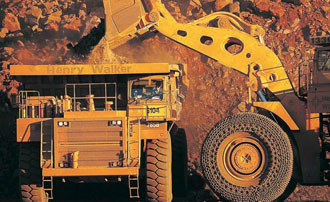
The value of Western Australia’s mineral and petroleum industry in 2013-14 set a new record of $121.6 billion, an increase of nearly 20 per cent compared to the previous year, according to the latest Department of Mines and Petroleum (DMP) statistics.
“The latest figures compiled by DMP show that iron ore remained the State’s highest value commodity, with a record $73.7 billion in sales,” DMP Director General Richard Sellers said.
“Project expansions and continuing strong demand led by China resulted in exports of 631 million tonnes, an increase of 23 per cent on 2012–13, along with a 31 per cent increase in value compared to the previous financial year.
“I am pleased that growth in other parts of the State’s mining and petroleum industry also helped support the value of the State’s resource industry.”
Mr Sellers said in 2013 14 there was increased output of gold, copper, lead, salt and diamonds and a significant rise in the value of petroleum sales, with LNG sales alone increasing by more than $1.9 billion to $14.4 billion.
Gold was the second most valuable mineral sector, with total sales of $8.8 billion, followed by alumina at $4.2 billion, then nickel at $3.5 billion.
“This new record was primarily the result of a weaker Australian dollar, which was an average 10.5 per cent lower compared to the previous year, aided by an increase in the value of iron ore produced,” he said.
Western Australia also remained the nation’s leading mining investment destination, attracting 52 per cent of total national capital spending valued at $90 billion.
“Fuelled by strong demand for resource commodities from Asia, new capital expenditure by the State’s mining industry has grown at an annual rate of 15 per cent during the five years to 2013–14,” Mr Sellers said.
As at September 2014, Western Australia had an estimated $160 billion worth of resource projects under construction or in the committed stage of development. A further $108 billion has been identified as being allocated to planned or possible projects in coming years.
“These impressive figures also show that the total value of royalties received by the State Government from the resources sector increased by 33 per cent from the 2012–13 financial year to reach a record $6.98 billion,” Mr Sellers said.
The petroleum sector, which includes crude oil, condensate, LNG, natural gas and LPG (butane and propane), was valued at $26.5 billion, an increase of nine per cent on the previous year. This increase was largely attributed to LNG and to a lesser extent natural gas.
Mineral and petroleum exports comprised about 90 per cent of the State’s total merchandise exports, representing the major contribution to Western Australia’s 48 per cent share of the nation’s total merchandise exports.
China remains WA’s major trading partner, taking 54 per cent of merchandise exports and is followed by Japan at 18 per cent, then South Korea at eight per cent.
“The dominance of the resources sector in the nation’s economy is expected to continue given the number of projects which have been expanded or developed, in particular iron ore and LNG,” Mr Sellers said.
Further information on the latest resources statistics for 2013-14 is available here.
Continuing reform of resources sector essential says Director General
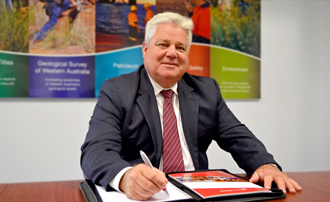
“It is essential that the current reforms within the resources sector continue in close consultation with industry, if the sector is to emerge successfully from the current easing in mineral commodities demand and pricing,” DMP Director General Richard Sellers said earlier this month at the Paydirt 2014 Australian Nickel Conference in Perth.
However, he said it was essential that any reforms did not add to the cost of doing business in Western Australia, nor detract from the State’s appeal as a destination for global investment in exploration and mining.
“One of the most successful outcomes to date of our reform is the slashing of the tenement titles approvals processes and backlog to its best level in more than two decades,” Mr Sellers said.
“When you consider there are more than 22,000 active mineral titles operating in Western Australia covering an area of almost 550,000 square kilometres, or just over one fifth of the State’s land mass, the department’s moves to cut the backlog of outstanding titles applications have seen this drop from more than 18,000 in 2007 to just over 4,000 today,” he said.
“This will reduce even further under our current push to expand the existing approvals transparency to other related government agencies including Aboriginal Affairs, Water, Environment Regulation, the Environmental Protection Authority and Parks and Wildlife.”
Mr Sellers said he could not stress strongly enough the importance of consultation in shaping WA’s resources future.
“Resources projects are having to be developed in an increasingly complex and challenging social and community environment,” he said.
“This environment demands that industry has greater environmental, economic and social accountability which in itself highlights the importance of transparent decision making and community engagement for the successful delivery of new resources projects.
“The challenge Western Australia now faces is the ability to sustain growth of the resources sector and remain an attractive investment destination and that includes agencies such as ours helping build confidence with stakeholders and the community.”
He said the value of Western Australia’s resources in 2013-14 was a record $121.6 billion with nickel coming in as the State’s fourth most valuable mineral sector at $3.5 billion.
For the first half of that year, US dollar prices negatively impacted the sector but a combination of rising prices and the weakening Australian dollar resulted in an increased price of around two per cent for nickel producers in 2013-14.
In the same period, the quantity of WA nickel sales fell by nine per cent to 209,000 tonnes, while the total value fell by four per cent.
However, nickel had particularly benefited from the State’s Exploration Incentive Scheme (EIS) which had, since 2009, seen its flagship Co-funded Exploration Drilling Program offer more than $50 million to more than 460 resources projects in Western Australia, with many projects including nickel and base metals targets.
In 2013-14, there were 33 nickel discoveries across the State – part now of a total of 271 projects where nickel or base metals are being targeted.
Mr Sellers said the Mining Rehabilitation Fund - introduced on a voluntary ‘opt-in’ basis in July last year and made compulsory this July to boost WA’s exploration and mining investment – saw more than 95 per cent of tenement holders meet the 30 June 2014 compliance deadline.
The department had already retired more than $290 million in environmental bonds over the past year and a further $900 million in bonds should be retired over the next 12 months.
“This will free up much needed funds for new exploration or mine development,” he said.
Interest earned on the fund will be used to pay for its administration and to undertake rehabilitation works on abandoned mine sites throughout the State, leading to better environmental and community safety outcomes.
Mr Sellers said the fund was a world first and was now being reviewed for possible introduction by other Australian states.
WA’s World Class Royalty System
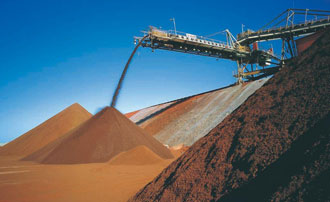
Recently released figures by the Department of Mines and Petroleum (DMP) show that the total value of royalties from the resources sector increased by 33 per cent from the 2012–13 financial year to reach a record $6.98 billion during 2013-14.
Western Australia’s royalty system has been in place since the early 1980s, and is highly regarded around the world.
The royalty system is based on the fundamental principle that the State’s petroleum and mineral resources are owned by the Crown, and the right to extract these resources comes with an obligation to pay royalties to the State.
DMP’s Director General Mr Richard Sellers said it was important companies continued to respect their obligation to pay the appropriate royalty.
“A royalty is not a tax,” he said. “It is a purchase price paid by a company to the community.”
“The State’s royalty system has been benefiting all Western Australians for decades. It enables the government to fund infrastructure programs, schools and hospitals.”
The system is designed to balance equity, efficiency, stability, predictability, transparency and simplicity.
Royalty rates are generally applied to the value of the resource in the final product, with the rates reducing according to the level of processing.
For example, bulk material attracts a royalty rate of 7.5 per cent, concentrates 5 per cent and metals 2.5 per cent.
DMP’s new online system allows companies to view, pay and monitor their royalty obligations.
In the 2012 State Budget, the State Government announced a Mineral Royalty Rate Analysis to review Western Australia’s royalty arrangements.
The analysis is being conducted by DMP and the Department of State Development (DSD) and is on track to report to the government by the end of 2014.
Record approval time for Nova discovery
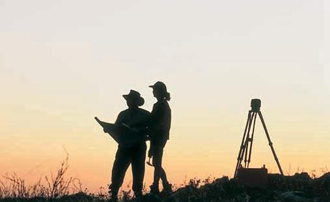
Western Australia’s improved approvals processes will boost the likelihood of the Sirius Resources Nova nickel, copper and cobalt deposit in the Fraser Range commencing as early as 2015.
“Since the greenfields discovery the Department of Mines and Petroleum’s (DMP) Mineral Titles division has worked closely with the company to ensure the minimum time possible to grant a Mining Lease for the project,” DMP Director General Richard Sellers said.
He said the Mineral Titles division had pulled out all the stops to process the application in 25 business days, rather than the target period of 65 days, due to the significance of the discovery.
“The Department continues to work to reduce the time taken for approvals, and this Mining Lease has benefited from the introduction of electronic processing of applications,” Mr Sellers said.
DMP’s Geological Survey of Western Australia (GSWA) provided geophysical and geochemical data that assisted in the discovery, while the first diamond drillhole at Nova received co-funding under the Exploration Incentive Scheme (EIS) scheme.
Sirius’ Managing Director Mark Bennett applauded the efforts of the department to expedite the granting of the Mining Lease, which was signed off just nine business days after the signing of a Mining Access Agreement with the traditional owners.
He said this was another important milestone in the company’s path to creating the best nickel mine in Australia.
“I would like to acknowledge the efforts of the staff of DMP who have made this process so efficient, and also the goodwill shown by both the department and the Minister for Mines and Petroleum Bill Marmion throughout the past two years,” Mr Bennett said.
Since its inception in 2009, the EIS Co-funded Drilling Program has offered almost $50 million in grants to more than 460 exploration drilling projects.
The State Government’s commitment to explorers under the EIS is expected to reach about $130 million by 2016–17.
Up to $5 million will be made available through Round 10 of the Co-funded Drilling Program to suitable projects to provide incentives to drill in underexplored areas during 2015.
Harmonised safety legislation on the drawing board
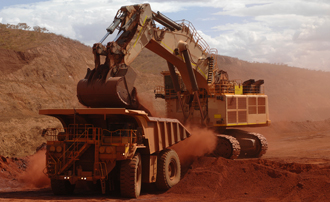
A new Resources Safety Bill to modernise and harmonise the State’s mine safety regulation with other jurisdictions throughout Australia has gained State Government support.
Department of Mines and Petroleum (DMP) Director General Richard Sellers said the Bill would initially cover mines safety and will replace the Mines Safety and Inspection Act 1994.
“The potential for incorporating safety legislation for petroleum and major hazard facilities will also be investigated towards the end of the 2014, through a formal Regulatory Impact Statement consultation process,” Mr Sellers said.
The new mines safety legislation will incorporate the best elements of the nationally-developed model Work Health and Safety legislation and the National Mine Safety Framework
However, DMP’s Resources Safety Executive Director Simon Ridge said any aspects of the model laws that didn’t suit the WA context would be amended or removed altogether.
“It is important to recognise that some aspects that work in other jurisdictions may not apply to Western Australia,” Mr Ridge said.
The new legislation is an important next step in further reducing the risk of harm in Western Australia’s resources industry, with a greater focus on risk management and a less prescriptive approach.
“The onus will be placed on industry to demonstrate they understand the hazards and have control measures in place,” Mr Ridge said.
He said a Ministerial Advisory Panel on Safety Legislation Reform was established with industry and the unions to ensure appropriate input into the decision-making process.
The panel has met four times since it was established in January 2014, making recommendations to the department and the Minister on the development and implementation of the reforms.
At the same time, the Work Health and Safety (WHS) legislation for general industry will be released for comment.
Canning Coastal Seismic Survey completed
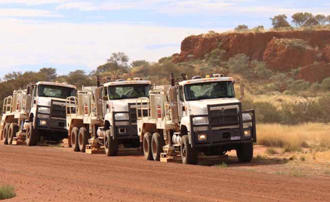
A 700 km, five-week road trip in the Kimberley that was completed at the end of June has wrapped up field work for the Canning Basin Seismic Survey.
“However, it will take up to a year to process and interpret almost two terabytes of information before the Department of Mines and Petroleum (DMP) can publish the results online,” DMP Director General Richard Sellers said.
The aim of the $3.65 million project funded by the State Government’s Exploration Incentive Scheme (EIS) is a better understanding of the geology of the region.
“Deep crustal seismic surveys such as this one provide information that shows us how the Australian continent was assembled as a result of plate tectonic process over billions of years,” DMP Geological Survey Executive Director Rick Rogerson said.
Dr Rogerson said that the Canning Basin survey was building on important geophysical surveys DMP had undertaken as part of the Kimberley Science and Conservation Strategy.
“Those surveys revealed details of the crust and upper mantle under the Kimberley,” he said.
“Now we want to see what the relationships are between the ancient rocks of the Pilbara region and the crust under the Kimberley, and the junction between these is under the Canning Basin.”
A massive amount of data was recorded by a convoy of about 20 vehicles with a crew of about 40 people that inched along the highway from Port Hedland, past Broome and Derby and on to the Gibb River Road.
Each day three specialised trucks would stop every 40 metres and deploy large metal pads to create minute vibrations barely perceptible to people 100 metres away but capable of penetrating up to 50km to 60 km deep through the crust and upper mantle.
“We hope the information answers some big questions about the geological framework of Western Australia,” Dr Rogerson said.
“An important use of the information from the top few kilometres in depth is in identifying areas that may be prospective for minerals and petroleum.”
Senior Geoscientist Louise Stelfox said the department was indebted to the Kimberley community for their assistance and patience during traffic disruptions caused by the survey.
The survey is a collaborative research project between DMP and the Australian Government’s Geoscience Australia under the National Collaborative Framework, with Geoscience Australia managing the contract.
It links up with other important deep-crustal surveys undertaken by the department and Geoscience Australia, and adds to the growing number of deep crustal seismic reflection surveys that have been collected right across Australia as part of the Federal and State government co-funded National GeoTransect Program.
New director for Dangerous Goods and Petroleum Safety and State Mining Engineer appointed
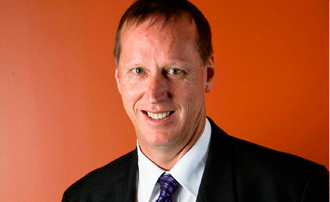
New Director for Dangerous Goods and Petroleum Safety Ross Stidolph.
Mr Chaplyn, who is also DMP Mines Safety Director has taken over the role from Resources Safety Executive Director Simon Ridge.
He has more than 30 years’ experience in the mining industry and is highly suited to the position, working previously as a regional and district inspector.
The role of the State Mining Engineer is to administer the provisions under the Mines Safety and Inspection Act 1994, which include managing the State’s mine safety inspectorate, approving key mining submissions and chairing the Board of Examiners and the Mines Survey Board.
Mr Chaplyn’s new appointment will complement his current role as Mines Safety Director at DMP, a position he has held since 2012.
He has also been a key member of the management team responsible for the Reform and Development at Resources Safety program (RADARS) since 2010.
He has a Bachelor of Engineering in mining from the Western Australian School of Mines (WASM) and more than 25 years’ experience working in the mining industry prior to joining the State Government.
The position of State Mining Engineer has been a proud part of Western Australia’s mining history since 1902 and plays a vital role in maintaining high safety standards across industry.
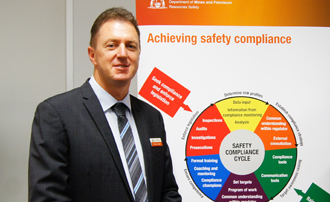
New State Mining Engineer, Andrew Chaplyn.
Department of Mines and Petroleum (DMP) Director General Richard Sellers has announced two recent executive appointments at the Resources Safety Division (RSD).
“Following a structural review, the department’s dangerous goods and petroleum safety branches were merged on 1 July this year,” Mr Sellers said.
He said Ross Stidolph had been appointed the new Director for Dangerous Goods and Petroleum Safety.
“The new branch brings together two regulatory groups that manage similar safety issues, creating a more consistent and robust regulatory approach to critical risk assessment,” Mr Sellers said.
He said Mr Stidolph would be an invaluable leader for the new branch, with more than 30 years’ experience in the oil and gas industry.
An engineer by trade, Mr Stidolph has spent most of his career working in management positions at Kwinana’s BP refinery, one of the largest major hazard facilities in the State.
“He has extensive experience with the department’s safety regulations and brings a unique operators’ perspective to safety performance and obligations,” Mr Sellers said.
Mr Stidolph’s new role will initially focus on delivering dangerous goods regulatory reforms and completing a statutory review of the Dangerous Goods Safety Act.
“I am very passionate about working to provide better safety outcomes and processes for industry,” he said.
“One of the major achievements in my career to date has been the significant improvement in safety performance that occurred during my time at Verve Energy (now Synergy) as Chief Operating Officer.”
Mr Stidolph said another highlight was working in Scotland for four years at Grangemouth’s major petrochemical complex where the North Sea’s oil and gas pipeline terminates.
In another senior appointment Andrew Chaplyn has been appointed Western Australia’s 11th State Mining Engineer.
Mines inspectors welcomed at forum
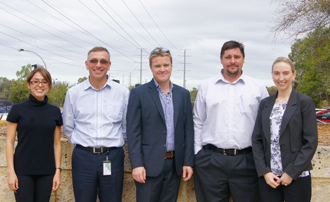
The newest recruits to Western Australia’s mines safety inspectorate have been recognised at the recent Department of Mines and Petroleum’s (DMP) safety forum.
The two-day Biannual Mines Inspectors Forum gives the State’s inspectors an opportunity to come together and share experiences, ideas and advice about mine safety.
The department’s Mines Safety Director and recently appointed State Mining Engineer Andrew Chaplyn said the forum was an important part of the Reform and Development at Resources Safety program (RADARS).
“The forums really give us the opportunity to come together as an inspectorate and look at how our reform program is going,” Mr Chaplyn said.
“Getting feedback from our inspectors to see what is working and where we need to improve is an important part of this process.”
Mr Chaplyn said the recent forum was focused on areas of concern raised by inspectors at the previous March forum.
“At the March forum, inspectors discussed our progress on priority targets and what needed to be addressed in the next few years,” Mr Chaplyn said.
Key issues were hazard awareness and control, risk management strategies, and effective leadership and cultural change.
These issues were further broken down into specific areas of concern.
"This kind of focus will help us to develop and implement strategies around these specific areas of concern,” Mr Chaplyn said.
“It will also promote consistency among the mines inspectors and explain the department’s approach to safety compliance in a practical way for industry.”
Mr Chaplyn said department officers were committed to working together to improve safety in Western Australia’s mining industry.
“Workers, employers, industry groups, regulators and government need to continue working together to make real, significant and sustained improvements to safety,” he said.
New guidelines for mine safety
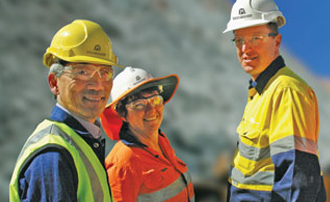
Resources Safety has released draft guidelines on safety and health supervision in WA mines for industry comment.
A study undertaken by the Department of Mines and Petroleum (DMP) in 2013 identified the first two years of employment as the highest risk period for accidents at work in mining.
The blueprint, developed by DMP’s Resources Safety Division, maps out how to develop, authorise, provide and maintain workplace safety and health systems to support effective management and supervision.
The guidelines, entitled Effective safety and health supervision in Western Australian mining operations, define the key safety roles for each level of management but focus on frontline supervision.
The blueprint promotes a systematic approach of planning, doing, checking and acting that supports a risk-based approach to safety and health.
"Effective management and supervision can only be achieved through a multi-tiered, team approach where each level of the organisation plays a part in implementing the overall safe systems of work," according to the draft guidelines.
"Supervisors depend on direction and support from middle and senior management, as well as the involvement of the workers and contractors they direct."
While there has been a notable improvement in mine safety trends during the past decade, the department is continuing its work to reduce mine fatalities.
DMP team visit Carnarvon and Mid West to talk about shale and tight gas
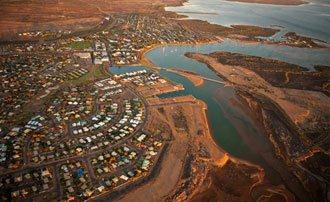
Briefings from senior staff from the Department of Mines and Petroleum (DMP) on how it is regulating the shale and tight gas industry have been recently held in Carnarvon and Mingenew.
Carnarvon Shire councillors and staff, and members of a local water advisory group were briefed following requests for more information on the emerging industry and the associated process of hydraulic fracturing.
At the end of last month DMP staff also manned a booth during the two-day Mid West Expo following similar requests.
DMP Director General Richard Sellers said the department was keen to let the community know how the industry in Western Australia would be regulated.
“Having staff visit regional areas is an important part of DMP’s continuing program of community engagement to present people with factual information on shale and tight gas and hydraulic fracturing,” Mr Sellers said.
He said while people may have concerns about potential risks to water resources and the environment, the department wanted to reassure them that if the industry does go ahead it would be subject to stringent regulation by DMP.
However, the Director General said he expected it would be at least five to 10 years before the industry developed to any significant commercial production.
“I would like to reassure people that DMP’s regulations are already among the world’s most robust and will become even tougher when new resource management regulations become law, hopefully before the end of the year,” Mr Sellers said.
He said Western Australia’s regulatory framework for hydraulic fracturing was continually being improved in response to new scientific, technological and social considerations.
“Since we’re looking at the very early stages of exploration and evaluation the department is in the ideal position to learn from other jurisdictions around the world,” Mr Sellers said.
“Our approach to regulating the emerging industry is a whole-of-government approach, and DMP is working closely with other agencies responsible for upholding the State’s values to protect public health, the environment, water resources and equitable land use,” he said.
These agencies include the Departments of Agriculture and Food, Environment Regulation, Health, Parks and Wildlife, State Development and Water, and the Office of the Environmental Protection Authority.
All companies are required by law to go through stringent approvals processes before they can undertake hydraulic fracturing activities, and before approval is granted, companies must submit a list of all chemicals that may go into a well.
“If they don’t, they can’t drill – it’s as simple as that,” Mr Sellers said.
All chemicals intended to be used in drilling programs involving hydraulic fracturing are published on the department’s website at www.dmp.wa.gov.au
Working on engagement with DMP’s stakeholders
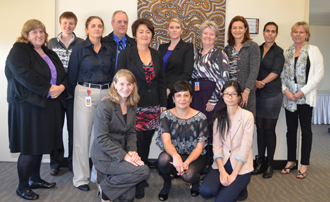
DMP's Stakeholder Engagement Working Group.
Department of Mines and Petroleum Director General Richard Sellers has announced the formation of a 20-member Stakeholder Engagement Working Group during a half-yearly review of the department’s operations.
Mr Sellers said the group included representatives from across the department, and would shape the future of stakeholder engagement at DMP.
“The Stakeholder Engagement Working Group is an opportunity for colleagues to collaborate in developing a stakeholder engagement policy for the department,” Mr Sellers said.
“The group includes at least one representative from each division within the department and will provide leadership and advice in developing DMP’s stakeholder engagement policies and procedures.”
He said the importance of transparency in stakeholder relationships could not be understated.
“Transparency and engagement with all stakeholders as early as possible is the single most important key to building a resources jurisdiction,” Mr Sellers said.
This engagement includes co-operation between all Australian states and territories.
“We are all one industry, so if a miner or oil and gas proponent is stopped for what we perceive as the wrong reasons in another jurisdiction, then that will flow on to us,” he said.
The Director General said he had always emphasised the value of transparency and engagement in the resources industry. When presenting the latest DMP strategic plan earlier this year, he highlighted to all staff the importance the department places on consultation.
“One of the key focuses for the department is building confidence with stakeholders and the community,” he said.
“This recognises the role meaningful stakeholder engagement plays in planning and developing good policies, programs, projects and services.”
Mr Sellers said the ultimate goal of the department was to ensure a safe, strong and responsible resources industry in Western Australia.
“Stakeholder confidence in DMP’s role – particularly its regulatory role – is crucial,” he said.
“Meaningful engagement between industry, government and the community is the key in producing good policy and realising the potential of WA’s resources industry.
“The Stakeholder Engagement Working Group will play an important part in the continued evolution of how the department engages with its stakeholders.”
Talking environmental reform at APPEA event
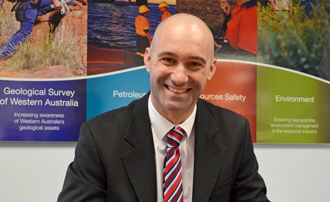
DMP Environment Executive Director Dr Phil Gorey.
Department of Mines and Petroleum (DMP) Environment Executive Director Dr Phil Gorey was one of the keynote presenters at a major oil and gas conference last month.
Dr Gorey spoke about environmental reforms in Western Australia at the 2014 Australian Petroleum Production and Exploration Association (APPEA) Health, Safety and Environment Conference.
“There have been a number of reforms across the department’s regulatory responsibilities – particularly environmental regulation,” Dr Gorey said.
“Events such as the APPEA conference give us a good opportunity to speak to a wide audience about these reforms.”
In 2012 the department announced the Reforming Environmental Regulation (RER) program.
“The RER program is implementing the principles of best practice regulation,” Dr Gorey said.
“This means we are shifting from a regulatory system that was more prescriptive and less targeted, to a risk-based system that allows us to better target our resources to where the greater environmental risks are.
“Another important part of the reform process has been meaningful and ongoing consultation with our stakeholders – from industry and government agencies, to environmental and community groups.”
Dr Gorey said the department was committed to ensuring the safe, sustainable development of a responsible resources industry in Western Australia.
“The Environment Division is committed to providing guidance, advice and, if needed, enforcement to ensure the State’s environmental assets are protected,” he said.
Industry gets opportunity to provide feedback on environmental reform
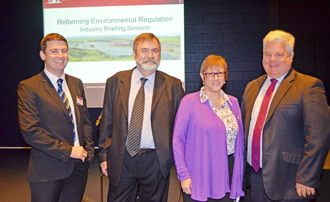
From left: At the R-E-R industry briefing sessions Senior Environmental Officer Tyler Sujdovic, Acting Executive Director Environment Steve Tantala, General Manager Administration and Reform Marnie Leybourne, and DMP Director General Richard Sellers.
More than 150 people attended a Department of Mines and Petroleum (DMP) industry briefing session earlier this month to hear about proposed reforms to environmental regulations.
Those in attendance received updates and were able to provide feedback on a number of DMP’s Reforming Environmental Regulation (RER) projects.
The briefing session coincided with the release of a discussion paper on mining proposal reform, one of the key priorities of RER.
Through the RER program, the department hopes to move away from prescriptive regulation and establish a risk and outcomes-based regulatory framework.
Opening the event, DMP Director General Richard Sellers said the department was working hard to involve industry and community in the reform process to make sure it got the recommendations right.
“We have a ministerial advisory panel and a number of working groups to advise on these proposed changes and make sure that what is put in place is practical and works for industry,” Mr Sellers said.
“In addition to industry members, these working groups include representatives from conservation groups, other government departments, local government, and members of the broader community.”
Question and answer sessions followed presentations by DMP environmental experts that included current and proposed legislative changes and operational reform, mining proposal reform, and the review of mine closure plan guidelines.
The session ended with a panel discussion that included all presenters and other DMP environment staff who fielded further questions from the audience.
The presentation slides from the industry briefing session are now available on the DMP website along with the mining proposal reform discussion paper at www.dmp.wa.gov.au/20808.aspx
Stricter rules for new mine rehabilitation fund
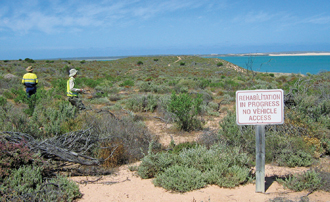
Environmental bonds will be withheld from mining tenement holders deemed at high risk of failing their obligations under the State Government’s new Mining Rehabilitation Fund (MRF).
Compliant tenement holders across the State became eligible to have their environmental bonds retired when they joined the MRF’s new levy system, which was made mandatory from 1 July, this year.
Department of Mines and Petroleum (DMP) Director General Richard Sellers said the old bonds system had resulted in $978 million of tenement holders’ funds being tied up.
“Historic bonds will be returned to tenement holders as soon as they have begun contributing to the new fund,” Mr Sellers said.
“This will assist the industry by freeing up cash for investment and ongoing rehabilitation.”
Almost 70 per cent of tenement holders had already registered for the fund, resulting in the department retiring bonds worth more than $290 million.
Under the MRF, the focus will be on avoiding environmental legacies left by abandoned projects.
In time, it is expected that interest raised from the new fund will go towards rehabilitating abandoned mines.
The levy is calculated on the amount and type of ground disturbed by an individual tenement holder’s activities, however tenement holders deemed high-risk would be required to pay, or maintain, their environmental bonds.
These risks could include being under administration, breaching environmental obligations or reporting requirements, and not making royalty payments.
Of the 22,086 tenements in WA about 17,000 mine sites have been abandoned over the past 130 years.
More information on the MRF can be found at http://www.dmp.wa.gov.au
Environmental offset guidelines released
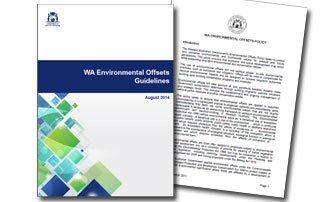
New guidelines setting the benchmark for the use of environmental offsets in the assessment and approval of resources projects were released by the State Government in August.
The guidelines complement the existing WA Environmental Offsets Policy released in 2011 and public Environmental Offsets Register released in 2013.
Department of Mines and Petroleum (DMP) Deputy Director General Dr Tim Griffin said the new environmental offset guidelines would provide greater clarity, consistency and accountability for regulators and industry alike.
“DMP was involved in the development of these guidelines and fully supports their introduction as they will ensure a standard approach across government agencies and help to provide greater transparency and accountability for setting environmental offsets,” Dr Griffin said.
“At the same time they will provide more consistency and certainty for project proponents.
“The guidelines will also provide assurance that environmental offsets are only considered as a last resort and will only be used to complement other approaches designed to reduce or mitigate environmental impacts on biodiversity and environmental values.”
Dr Griffin said industry peak bodies and conservation groups were consulted during the development of the guidelines.
He said the release of the guidelines marked another significant step in a series of State Government reforms.
The environmental offsets guidelines can be downloaded from http://www.dmp.wa.gov.au/environment_policy
Forging mining ties with Africa
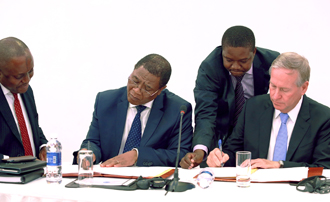
Premier Colin Barnett signing the Memorandum of Understanding (MoU).
The Department of Mines and Petroleum (DMP) has strengthened its bonds with the Common Market for Eastern and Southern Africa (COMESA) through a series of meetings and events at last month’s three-day Africa Down Under 2014 Conference in Perth.
The highlight for the department was the first face-to-face meeting of the Joint Working Group (JWG) established after Premier Colin Barnett signed a Memorandum of Understanding (MoU) between Western Australia and COMESA in January this year during his visit to Lusaka, Zambia.
The meeting followed an official State breakfast attended by the Premier, Mines and Petroleum Minister Bill Marmion, COMESA Secretary General Sindiso Ngwenya, COMESA officials and Ministers and representatives of DMP, and the Departments of State Development and Agriculture and Food.
The high-profile meeting of the JWG has helped to cement ties created at the inaugural meeting held by teleconference in May that set up parameters for the MoU’s governance arrangements and a 12-month work program.
The primary aim of the MoU is to tap Western Australia’s expertise to help African nations to develop their mining laws, tenement systems and environmental and safety standards to levels similar to those in Australia.
Western Australia has a world class system of legislation and regulation and wants to pass on its experience so African countries can build resources industries that are profitable, sustainable, safe, and pass on benefits to their citizens.
It is also expected that the MoU will bring benefits to Australian companies with investments in Africa.
Involvement with COMESA has been identified by the State Government as a highly effective way to have Western Australia recognised throughout the trade bloc’s 19 member states, which include Kenya, Uganda, Zambia, Egypt and Libya.
COMESA’s states have a combined population of 389 million, annual imports of about US$32 billion and exports of US$82 billion.
DMP also had a busy schedule of meetings and events involving COMESA and Africa Down Under delegates in the week before the conference.
The itinerary included trips around the Perth area including the department’s Core Library at Carlisle, and to Bunbury, Bridgetown, Greenbushes, Kwinana, and the North-West.
The department also delivered briefings to delegates on tenement management, royalty and taxation policies, environmental approvals, geoscience information, and key policy issues for developing a successful resources sector.
In association with the Department of State Development, DMP hosted a meet-and-greet session for COMESA delegates prior to the conference.
As part of the Africa Down Under conference, DMP Executive Director Environment Dr Phil Gorey took part in a panel discussion on challenges and innovation in environmental stewardship.
Dr Gorey visited South Africa this month to attend the Mine Closure 2014 Conference and held an environmental best practice workshop in Kampala, Uganda as part of his itinerary.
DMP welcomes new staff under Aboriginal Employment Strategy
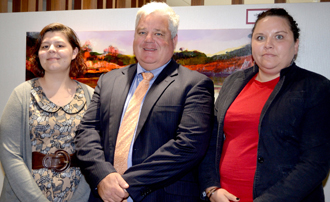
From left, 2014 Aboriginal Employment Strategy (AES) employees Alisha Dark and Kristy Spillman with DMP Director General Richard Sellers.
The highly successful Aboriginal Employment Strategy (AES) undertaken by the Department of Mines and Petroleum (DMP) has been busy over the past few months with the latest intake of Indigenous employees.
“This proactive employment strategy has seen another three Aboriginal people taking up Level 2 positions in our department,” DMP Director General Richard Sellers said.
He said each new recruit had been given a 12-month contract with the department, with the possibility of permanency.
“Each employee will be provided with a high level of support including workplace buddies, a structured mentoring program and training and skill development,” Mr Sellers said.
Since the inception of the AES in 2011, DMP has employed 17 Aboriginal staff through this employment strategy.
The new employees will be working across the department in Finance, Information Services and the Mineral Royalties branches.
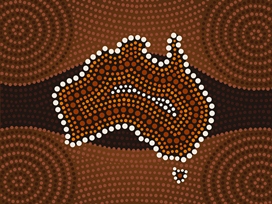
In early July, as part of the Reconciliation Action Plan (RAP), the department also celebrated NAIDOC Week.
This year’s theme was ‘Serving Country: Centenary and Beyond’ which acknowledged Aboriginal and Torres Strait Islanders who have served and are still serving in our armed forces.
To create awareness in our workplace about the contribution Aboriginal Australians have made to our armed forces, DMP organised a Veteran Photography Exhibit for staff and visitors.
Throughout the week the department also ran a screening of ‘The Forgotten’, a film examining the prejudice faced by Aboriginal and Torres Strait Islander soldiers in the armed forces.
A number of other events were also held throughout the week including a special dance performance by the Yonga Boys Dance Group, a traditional Aboriginal smoking ceremony and DMP’s second annual boomerang throwing challenging. DMP also participated in Ashfield Family Day held by the Town of Bassendean.
Welcome to country
The department continues to focus on the integration of the Welcome to Country Guidelines into normal business practice.
The guidelines provide advice to staff on when and how to use the Welcome to Country and Acknowledgement of Country at DMP events.
“DMP is committed to providing its staff with opportunities to learn about the culture and history of Aboriginal and Torres Strait Islander peoples,” Mr Sellers said.
“Practices such as Welcome to Country and Acknowledgment of Country enable the wider community to share in Aboriginal and Torres Strait Islander culture while acknowledging Aboriginal or Torres Strait Islanders as traditional custodians of the land.”
Senior DMP geoscientists complete joint fieldwork with China
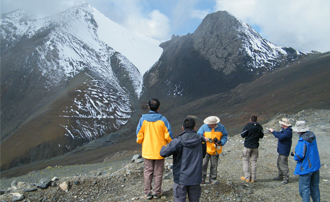
A senior delegation led by DMP’s Geological Survey of Western Australia (GSWA) Executive Director Dr Rick Rogerson returned last month following a tour to mark the end of the main phase of geological mapping in China’s Gansu Province.
The 12-day tour, part of a high-level Memorandum of Understanding (MoU) between DMP and the Chinese Ministry of Land Resources, included a two-day workshop with Chinese government officials and exploration and mining groups from surrounding regions.
Following the workshop, Dr Rogerson, and two other GSWA experts, joined a joint GSWA/China Geological Survey (CGS) field trip to the northern Tibet Plateau for three days of on-field discussions, including ongoing activities under the MoU beyond 2014.
GSWA’s Cooperation in Geoscience MoU with the CGS is the first major joint venture project with an Australian State geological survey and has already resulted in joint mapping exercises in the Yalgoo area of WA’s Murchison region, and the north west of China’s Gansu Province.
The Beijing-based geoscientific organisation also has six regional centres where pre-competitive projects are undertaken, along with research into geohazards such as coastal engineering, landslide risk mitigation and seismic-related damage litigation.
CGS identified GSWA as an organisation that was well-suited and well-recognised internationally to help them improve Chinese mapping techniques.
“The China Geological Survey wanted us to share the way we do things, and we went over to China to share our techniques and our mapping process, with an emphasis in understanding geology, rather than just doing maps,” Dr Rogerson said.
He said there were also benefits to GSWA geoscientists being exposed to younger, well exposed, examples of rocks and the rock systems in China, and it was an important learning experience.
Much of the geology of WA is extremely old, highly deformed and poorly exposed, and geologists rely on the ‘uniformitarian’ concept that ancient geological sequences evolved in the same way as modern sequences.
The areas examined in China, including those in the northern Tibet Plateau at the zone where two continents collided in the past, represent relatively young examples of some geological environments that are considered important in the geological evolution of the State.
This helps WA geocientists to understand ancient rocks in WA, mineral systems and the evolution of mineral deposits and, importantly, residual prospectivity.
GSWA techniques involve an integration of numerous geological disciplines such as geophysics, structural geology, geochemistry and geochronology which ultimately leads to a better understanding of geological evolution that allows for better assessment for prospectivity.
The systems developed by GSWA apply a more holistic and scientific approach to mapping and the survey is recognised as a world leader in digital mapping technology.
DMP announced as finalist for Premier’s Awards
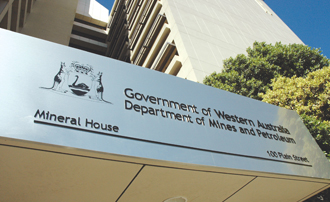
The Department of Mines and Petroleum (DMP) has been announced as a finalist in the 2014 Premier’s Awards for Excellence in Public Sector Management in the ‘Developing the Economy’ category.
DMP was nominated in this category for the Mining Rehabilitation Fund (MRF) project.
DMP Director General Richard Sellers said the category recognised projects which maximised opportunities for the future through stimulating the economy to support employment and growth in Western Australia.
“I am extremely pleased that the department has been acknowledged for its efforts in stimulating jobs and the economy,” Mr Sellers said.
He said that the MRF was a first of its kind, a new pooled fund contributed to by Western Australian mining operators.
All tenement holders are required to report disturbance data and contribute annually to the fund if their rehabilitation liability estimate exceeds $50,000.
Money in the fund will be available to finance rehabilitation of abandoned mines in the State, and interest earned on fund contributions will be available for rehabilitation of legacy abandoned mines.
The MRF became compulsory from 1 July 2014 after an initial 12-month ‘opt-in’ period and largely replaces the holding of unconditional performance bonds.
DMP was also nominated in the Improving Government category for Geo.VIEW.WA: Improving the Delivery of Geoscience and Resource Information.
Mr Sellers congratulated the teams behind both projects on the commendable work that resulted in their nominations.
“The teams behind the MRF and GeoVIEW.WA projects have worked exceptionally hard and are both very deserving of the recognition their nominations for these awards bring,” he said.
The Premier’s Awards will be presented in a ceremony on Wednesday 5 November.
DMP Core Library to expand
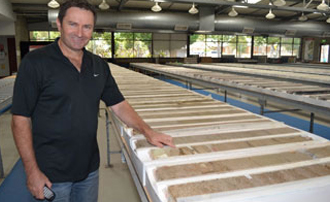
Core Librarian Paul Stephenson.
Department of Mines and Petroleum (DMP) Director General Richard Sellers has announced the expansion of the Core Library in Carlisle.
Mr Sellers said $4.8 million had been allocated for the expansion of the large warehouse that acts as a repository for drill core samples.
“This expansion will increase its storage capacity by about 50 per cent, or 3,500 square metres,” he said.
The Core Library archives State and Commonwealth drill samples which are crucial to new exploration research.
Core Librarian Paul Stephenson said companies were cutting exploration costs down to thousands of dollars instead of millions, because exploration geologists were able to look at samples in Carlisle.
Companies are required to submit cores, cuttings and sidewall core material obtained during drilling as part of the legislative requirements for petroleum and geothermal exploration.
These samples become available to the public after a strict confidentiality period.
Former Chief Paleontologist at DMP, Dr Kath Grey, said some fossils within the core samples were about 800 million years old.
She said the study of ancient fossil rocks, such as stromatolites, was vital for petroleum exploration research.
The facility is considered one of the most important resources in Western Australia for petroleum companies to do pre-analysis before moving to an expensive drill hole.
Mr Sellers said increased exploration activity mainly resulting from the Exploration Incentive Scheme (EIS) had made the expansion essential.
The Perth Core Library is currently about 81 per cent full.
It has about 7,000 pallets of samples stored and a total storage capacity of 8,640.
More information about Core Library services and drillcore is available from http://www.dmp.wa.gov.au/13453.aspx
Scholarship program invests in resources future
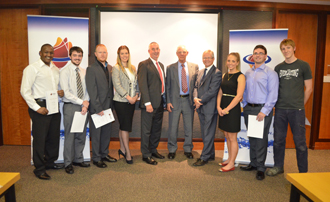
MRIWA scholarship recipients.
More than $1 million is being made available over the next three years towards research for Western Australia’s minerals and energy sector.
In June, the first part of the Minerals Research Institute of Western Australia (MRIWA) program saw the awarding of $16,000 in new scholarships for eight projects through the inaugural Odwyn Jones Awards.
The awards are the first of the MRIWA’s new scholarships program, replacing the Minerals and Energy Research Institute of Western Australia (MERIWA) scholarships awarded to PhD students since 1991.
The new program is named in honour of Professor Odwyn Jones who was involved with MERIWA for more than 30 years.
The awards will provide up to 15 annual scholarships of $2,000 for students to progress their fourth-year research projects. At the end of that year, award winners achieving first class honours would be eligible for a $3,000 prize.
Additionally, 10 Director’s PhD scholarships to the value of $960,000 would be offered during the program’s first three years of operation.
Since 1991, postgraduate minerals research scholarships have been awarded to 34 University of Western Australia students, 33 Curtin University students and nine Murdoch University students.
2014 Odwyn Jones Awards winners:
Murdoch University
Jonathan Adams: Leaching of rare earth element minerals
Edwyne Mutai: Leaching of copper arsenic sulphide
Joshua Vinicombe: The effect of pH and electrolytes on the rheology of nickel laterite.
Curtin University
Justin Brent: Determination and modelling of the reaction kinetics of the aeration of reduced ilmenite
Aiden Green: Determination and comparison of the limit equilibrium and finite element method for slope design and stability assessment at the Wodgina open cut mine
Holly Kiely: Analysis of La Mancha drilling efficiency
Shane Reynolds: Development of 3D maps to understand basin structure and cover development
Kelsey Roberts: Optimal stemming height for charge holes on standard production blasts at the Rio Tinto Brockman 4 mine.
Oil and gas veteran wins top industry award
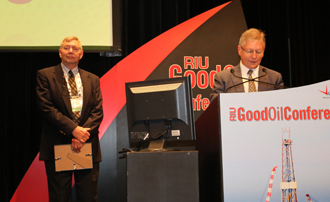
Former Executive Director of the Department of Mines and Petroleum’s (DMP) Petroleum Division Bill Tinapple was last month presented with the prestigious John Duran Lifetime Achievement Award.
It is the first time a former government employee has been honoured with the award.
DMP Director General Richard Sellers congratulated Mr Tinapple, a 40-year veteran of the oil and gas industy, on the award, saying it was a fitting tribute to a long and exemplary career in the oil and gas industry.
“The department was lucky to have Bill around to help develop Western Australia’s policy and regulation over the past 15 years,” Mr Sellers said.
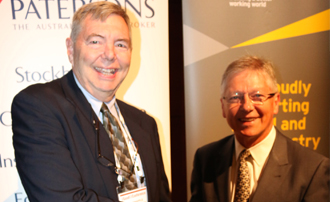
From left, Bill Tinapple with Mines and Petroleum Minister Bill Marmion.
“Bill’s experience and guidance is missed by his many friends and colleagues at DMP, and in the industry.
“He has a unique perspective through his background in engineering and as a regulator in both the Northern Territory and Western Australia.”
The John Duran Award is given to a member of the oil and gas community who has dedicated his or her life to promoting the junior and midcap sector.
While heading DMP’s Petroleum Division, Mr Tinapple played a leading role in a number of initiatives that improved customer service, increased investment in Western Australia, and sustained production.
He has been strongly involved with development of the oil and gas industry in Australia, from initial involvement in engineering studies for the North West Shelf through to the development of the first floating production, storage and offloading unit.
He was also involved in gas pipeline development, including the Amadeus to Darwin gas pipeline.
Mr Tinapple was instrumental in facilitating and encouraging the large multi-client 3D survey offshore campaign in the 1990s which greatly improved the rate of discovery of gasfields on the North West Shelf.
In his role as a regulator, he oversaw the changes within the department resulting from amendments to the Commonwealth’s offshore petroleum legislation (the Offshore Petroleum and Greenhouse Gas Storage Act 2006) which came into effect on 1 January 2012.
Originally from Ohio in the US, he has qualifications in engineering and a Master’s Degree in Business Administration.
Mr Tinapple settled permanently in Australia in 1985 and has worked in the United States, the United Kingdom, Libya, Indonesia, the North Sea, Norway, Nigeria, Japan, Australia and Abu Dhabi.
“Thanks to people of the calibre of Bill Tinapple, Western Australia is now the leading location in the world for liquefied natural gas,” Mines and Petroleum Minister Mr Marmion said while presenting the award during the Good Oil Conference 2014 held in Fremantle.
New name for resources research institute
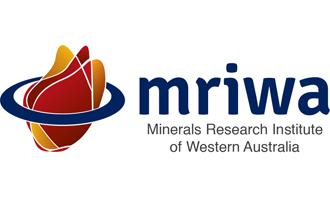
One of Western Australia's premier minerals research institutes has been recently renamed and relaunched.
Over the past 33 years the newly named Minerals Research Institute of Western Australia (MRIWA) has played a vital role in establishing Western Australia as an international centre of excellence for minerals research.
The institute will help ensure Western Australia's reputation for world-class research and development in the resources industry continues to be recognised across the globe.
The institute was previously called the Minerals and Energy Research Institute of Western Australia (MERIWA) and was a statutory body established by the Western Australian Government Minerals and Energy Research Act 1987.
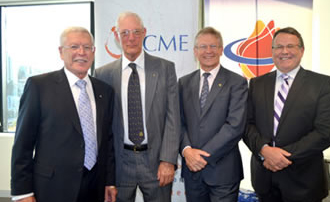
From left, former Mines Minister Norman Moore, MRIWA CEO Mark Woffenden, Minister for Mines and Petroleum, Bill Marmion and CME Chief Executive, Reg Howard-Smith.
Since it was established, the institute has published more than 300 research reports.
The new institute will play an important role in the goal to make Western Australia the world's capital for minerals and energy research by the end of the decade.
More information is available at http://www.mriwa.wa.gov.au/
In-water hull cleaning system takes 2014 Golden Gecko
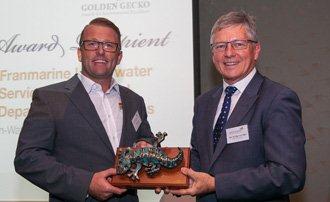
Sam Lane, from Franmarine Underwater Services, with Minister for Mines and Petroleum Bill Marmion.
A project that eradicates bio-fouling of large marine vessels has been awarded the prestigious Golden Gecko Award for Environmental Excellence for 2014.
Franmarine Underwater Services and the Department of Fisheries were awarded this year’s Golden Gecko for their collaboration on an in-water hull cleaning system.
Department of Mines and Petroleum (DMP) Director General Richard Sellers said that this year’s Golden Gecko recipient excelled across all four of the assessment criteria.
“The in-water hull cleaning system focuses on prevention rather than cure when it comes to eradicating marine bio-fouling,” Mr Sellers said.
“The system promotes a preventative risk-management approach to biosecurity, and a clean-hull operating policy for Western Australian waters.
“The project sets a precedent for in-water hull cleaning, being able to remove marine bio-foulant down to a size of 50 microns, which is well below the industry standards and requirements.
“It is also economically compelling as using the in-water hull cleaning system means ships don’t have to travel to Singapore to be dry docked and cleaned.”
A Golden Gecko Certificate of Merit was also presented to GeoOceans Pty Ltd for the project, GO Visions Marine Habitat Mapping and Monitoring Technology.
The GO Visions technology enables rapid assessment and monitoring of large areas of coastal marine habitats following an oil spill.
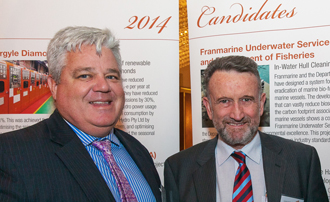
From Left, DMP Director General Richard Sellers with GSWA Executive Director Rick Rogerson.
Mr Sellers said the GO Visions technology makes collecting marine habitat data more efficient and accurate.
The diverless subsea technology employed also makes data collection safer.
The six finalists for the 2014 Golden Gecko Awards were:
- Argyle Diamonds Limited
- Environmental Rehabilitation WA
- Evolution Mining Edna May Operations
- Franmarine Underwater Services Pty Ltd and Department of Fisheries
- Geo Oceans Pty Ltd
- Newcrest Mining Limited
Anyone interested in submitting a project for the 2015 Golden Gecko Awards should visit www.dmp.wa.gov.au/goldengeckofor details.
Global safety experts in Perth
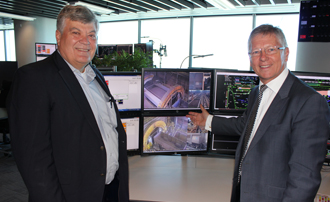
ISO Technical Committee Chairman Dan Roley launched the workshop with Mines and Petroleum Minister Bill Marmion at BHP Billiton Iron Ore’s Integrated Remote Operations Centre.
An international expert leading the development of global safety standards for autonomous mining machinery was in Perth for an automation workshop hosted by the Department of Mines and Petroleum (DMP) and the Chamber of Minerals and Energy WA (CMEWA) last month.
Dan Roley, who chairs the International Organisation of Standardisation (ISO) technical committee on mobile autonomous mining systems, said the workshop offered a good opportunity to have input from Australian experts in the development of global safety standards.
The ISO technical committee also held a working group meeting.
“The technical committee develops commercial and safety standards for machines used in earthmoving, mining, and general construction,” Dr Roley said.
“We continually develop new standards and revise current standards to address new types of machines, new applications and new technology.
“The ISO standards are developed with cooperation between machine users, health and safety organisations, and manufacturers to achieve the common goal of developing machines that can be used safely.”
DMP’s Director Mines Safety Andrew Chaplyn said the workshop provided input into the ISO standards.
“Our State is the first jurisdiction in the world to develop safety guidance covering autonomous equipment in the mining industry,” Mr Chaplyn said.
“Western Australia is at the forefront in the use of this technology, so it makes sense that we provide input into the development of the ISO standards from a regulator and operator’s perspective.
“The guidance documents were developed by a team comprising representatives from equipment manufacturers, mining companies, technology experts, as well as the regulator.
“With ISO holding its working group meeting here in Perth, we have an opportunity to liaise with international experts in the field and, if necessary, revise the guidance to ensure the best safety outcomes for the industry in WA.”